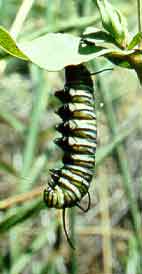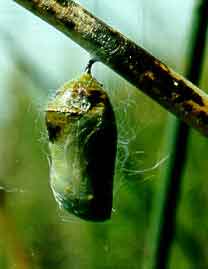Behind
Every Great Butterfly is a Great Caterpillar
 Every butterfly you see is technically a senior
citizen. It has already lived most of its life, mainly in a form that
is very different from the butterfly. Butterflies lay eggs, like other
insects. From each egg hatches a caterpillar, the larval stage of a butterfly.
Its sole purpose in life is to find its host plant and consume as much of it
as it possibly can!
Every butterfly you see is technically a senior
citizen. It has already lived most of its life, mainly in a form that
is very different from the butterfly. Butterflies lay eggs, like other
insects. From each egg hatches a caterpillar, the larval stage of a butterfly.
Its sole purpose in life is to find its host plant and consume as much of it
as it possibly can!
Caterpillars
are obviously much different than butterflies. Wingless, they get around on
three pairs of jointed, or "true" legs, and five pairs of prolegs.
Caterpillars are equipped with special chewing mouthparts, silk producing glands,
and possibly defensive structures, such as hairs or spines. As the caterpillar
eats it grows, but its growth is limited by the size of its unstretchable skin.
To get around this limitation, it molts - sheds its own skin. Each caterpillar
will molt several times during its life; the stage in between each molt is called
an instar. As you might expect, the second instar is larger than the first,
the third is larger than the second, and so on.
 The very last molt
produces, not another instar, but a pupa. Butterfly pupae have a smooth
outer covering, called the chrysalis. Some butterfly pupae are additionally
covered with strands of silk forming a cocoon. Within the pupa, metamorphosis
takes place. This is the process where the entire body of the insect is
literally rearranged to produce an adult butterfly. When complete, the
butterfly emerges from the chrysalis by crawling out of a split in the pupa's
skin, and prepares its wings for flight. Then it's off to find food and
love!
The very last molt
produces, not another instar, but a pupa. Butterfly pupae have a smooth
outer covering, called the chrysalis. Some butterfly pupae are additionally
covered with strands of silk forming a cocoon. Within the pupa, metamorphosis
takes place. This is the process where the entire body of the insect is
literally rearranged to produce an adult butterfly. When complete, the
butterfly emerges from the chrysalis by crawling out of a split in the pupa's
skin, and prepares its wings for flight. Then it's off to find food and
love!
 Every butterfly you see is technically a senior
citizen. It has already lived most of its life, mainly in a form that
is very different from the butterfly. Butterflies lay eggs, like other
insects. From each egg hatches a caterpillar, the larval stage of a butterfly.
Its sole purpose in life is to find its host plant and consume as much of it
as it possibly can!
Every butterfly you see is technically a senior
citizen. It has already lived most of its life, mainly in a form that
is very different from the butterfly. Butterflies lay eggs, like other
insects. From each egg hatches a caterpillar, the larval stage of a butterfly.
Its sole purpose in life is to find its host plant and consume as much of it
as it possibly can! The very last molt
produces, not another instar, but a pupa. Butterfly pupae have a smooth
outer covering, called the chrysalis. Some butterfly pupae are additionally
covered with strands of silk forming a cocoon. Within the pupa, metamorphosis
takes place. This is the process where the entire body of the insect is
literally rearranged to produce an adult butterfly. When complete, the
butterfly emerges from the chrysalis by crawling out of a split in the pupa's
skin, and prepares its wings for flight. Then it's off to find food and
love!
The very last molt
produces, not another instar, but a pupa. Butterfly pupae have a smooth
outer covering, called the chrysalis. Some butterfly pupae are additionally
covered with strands of silk forming a cocoon. Within the pupa, metamorphosis
takes place. This is the process where the entire body of the insect is
literally rearranged to produce an adult butterfly. When complete, the
butterfly emerges from the chrysalis by crawling out of a split in the pupa's
skin, and prepares its wings for flight. Then it's off to find food and
love!